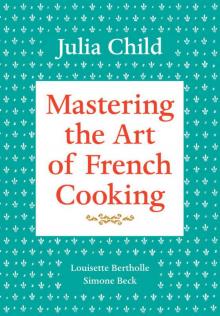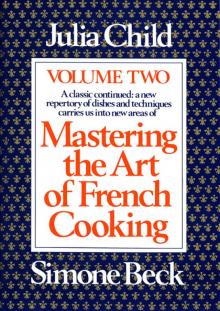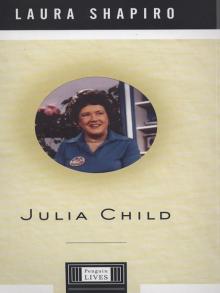- Home
- Julia Child
Laura Shapiro Page 11
Laura Shapiro Read online
Page 11
At the same time, however, she tended her public image with great care. Paul did all the still photography for The French Chef and tried to make sure that his were the only photographs of Julia that appeared in the press. She was not conventionally good-looking or particularly photogenic, and newspaper photographers weren’t going to edit their contact sheets as painstakingly as he did. As he told his brother, “The image can be spoiled by letting out half a dozen stinkers.” Over the years, similarly, she went on many diets but rarely discussed them in public until late in her career. What she preferred to tell the press, when reporters invariably asked how she controlled her weight in the face of so much tempting food, was that she and Paul simply watched their calories and tried never to have second helpings. (But, “TOO FAT!” she groaned to an old friend. “I’m just too damned fat, my waist is middle aged, my bust is bulging bubbidom, and [worst of all], I really can’t buy any clothes anymore.”) A few years after she started on television, she bought her first wig—“which will save a pile of distress in rainy weather,” Paul explained—and in the late 1960s, she had plastic surgery for the first time, an “eye job.” In the spring of 1971, she had a complete face-lift. The operation took place in Paris so that she could go straight to their house in Provence to recuperate in absolute privacy. When she learned that Simca was planning to be next door in her house at the same time—Simca would be working with an American writer who was translating her cookbook into English—Julia insisted that the translating be done elsewhere or at another time. “You forget, ma chérie, that I am, malgré tout, a public figure and it will not do to have a reporter and writer be aware in any way of my condition,” she wrote to her colleague. “I am sorry to be difficult about this, but you must understand the problem!” Nobody knew about the face-lift—“my sacquepage,” Julia called it—except Paul, Simca, and Ruth Lockwood. “People think I look just fine, and so rested,” she wrote to Simca after returning home. “Avis said your skin looks so good, and your face—I said, well, since the TV I’ve learned how to put on makeup. Actually, it is very subtle—the neck fixed, the pouches at either side of the chin, and the hollows out of the cheeks. I didn’t realize myself until suddenly I looked—no turkey neck! No dewlaps!” She had plastic surgery again in 1977 and once more in 1989.
But her image was a bigger project than simply the condition of her face and figure. Soon after The French Chef became a local sensation, Julia began to get invitations—Would she appear at a department store and demonstrate cooking? Would she appear at a charity fund-raiser? Would she endorse this product, use this equipment on air, plug this restaurant? Early on, she made it a rule to say no to everything except charitable ventures. “I just don’t want to be in any way associated with commercialism (except for selling the book in a dignified way), and don’t want to get into the realm of being a piece of property trotting about hither and yon,” she told Koshland. “The line is sometimes difficult to see, but I know where I mean it to be.” Anytime she accepted a fee for a cooking demonstration or a special appearance, she donated the money to WGBH. If viewers wrote to ask where she bought her mixer, or what brand of rum she was using, she wrote back with the information, but she never mentioned a brand name in public. Thanks to the success of her books, as well as an inheritance, she and Paul didn’t need the money; and she often said how grateful she was to be able to turn down such offers. But she made her stance for another reason as well. Commercial endorsements were demeaning: they tarnished the reputation of the cook. James Beard lent his name to many food companies, always justifying it by saying he needed the money, and Julia felt that his standing in the profession was suffering as a result. Audiences understood the difference between paid-for and unfettered speech; they loved her for staying on the right side of the line, and she had no intention of letting them down by muddying what she called “the purest of noncommercial images.”
With the help of her lawyer when necessary, Julia kept her name free of commercial taint throughout her career. But other aspects of her public image had a way of tripping her up, often right on air. Scrupulous though she was about how she looked and how she taught, Julia was so comfortably at home whenever she was handling food that she moved around the TV kitchen as if she were in her own house. She stashed away the colander and then forgot where it was, hunted about for the mixing fork, lost track of a casserole; once she snatched up a huge handful of paper towels and swabbed her face, explaining, “I’ve got so many burners on here, I’m hot.” No matter how well she planned a program, moreover, reality had a way of breaking over the proceedings like a raw egg. Julia’s equanimity in the face of a crisis was dazzling—repairing the molded potatoes that stuck to the bottom of the pan, withstanding a series of electrical shocks from the microphone tucked in her blouse (she did keep fiddling anxiously with the mic, but she never stopped teaching), shoving aside a spoon holder that had fallen over with a crash, ignoring a scraper that flew from her grasp, and dismissing the collapse of a frosting-laden “twig” in the Yule log by remarking, “Well, I guess that would happen in a forest, anyway. Things sitting there a long time, and they begin losing their strength.” When she unmolded a tarte tatin, only to see it collapse into a messy heap of apples with the crust slipping off to the side, she simply said, “That was a little loose. But I’ll just have to show you that it’s not going to make too much of a difference, because it’s all going to fix up.” Rapidly she tucked the apples together on top of the crust, then carried the disheveled tart into the dining room along with another “ready” tart that had been unmolded perfectly earlier in the day. “Now everybody can get one of each tart,” she said as she cut slices, managing despite everything to sound like a chemistry teacher showing the results of an experiment that went off just as it was supposed to. “There. I think that actually makes a more interesting dessert.”
One day Julia taped a program with four different potato recipes, trying to move through them at a good pace. Standing at the stove over a large mashed potato cake in a skillet, she waited a little impatiently for the cake to brown on the bottom. She eyed the pan and shook it dubiously, then decided to try to flip the cake over anyway. Clearly she knew she was taking a chance. “When you flip anything, you just have to have the courage of your convictions, particularly if it’s sort of a loose mass, like this.” She gave the pan a swift, practiced jerk. The potato cake rose heavily into the air and disintegrated, half of it spilling in shreds onto the stove. “Well, that didn’t go very well,” she observed steadily. “You see, when I flipped it, I didn’t have the courage to do it the way I should have.” Quickly she gathered up the pieces and reassembled them in the pan. “You can always pick it up,” she remarked as she worked. “You’re alone in the kitchen—who is going to see? But the only way you learn how to flip things is just to flip them.”
“You’re alone in the kitchen—who is going to see?” This incident became legendary and then apocryphal, revised so many times in the telling that the original event disappeared. Julia dropped a chicken, Julia dropped two chickens, she dropped a turkey, a twenty-five-pound turkey, a pig, a duck, and in each case blithely returned them to their platters—all fantasies, but people recalled them joyfully. They also remembered seeing Julia pour wine into a dish, then finish off the bottle herself, saying, “One of the rewards of being a cook.” Actually, she had been showing how to juice tomatoes and finished the lesson by drinking up the last bit of juice; but memory preferred wine. “Sometimes she forgets to put the seasoning in the ragout; sometimes she drops a turkey in the sink,” wrote Lewis Lapham in the Saturday Evening Post. “In New York’s Greenwich Village…a coterie of avant-garde painters and musicians gathers each week in a loft to watch The French Chef, convinced that Mrs. Child is far more diverting than any professional comedian.” A story in Time played up her “muddleheaded nonchalance”; a piece in TV Guide reported “blunders,” “grunts,” and “mutters.” “Practically every article on Julie so far has concentrated on the clown in
stead of the woman, the cook, the expert or the revolutionary,” Paul complained to his brother. Julia hadn’t intended to do kitchen vaudeville, but that was the image taking shape—despite the fact that efficiency and competence characterized her television cooking far more accurately than pratfalls did.
Reading the fan mail as well as the press, Julia could see that the informality and humor that came so naturally were doing just what she wanted the show to do: dispel the fog of intimidation around French cooking. Hence she was willing to play up the entertainment aspect of the program, especially in the opening moments—sorting through mounds of tangled seaweed to reveal a twenty-pound lobster, for instance, or standing over a chorus line of six raw chickens exclaiming, “Julia Child presents the chicken sisters! Miss Broiler! Miss Fryer! Miss Roaster! Miss Caponette! Miss Stewer! And old Madame Hen!” But she was of two minds about the bloopers. They were peerless teaching tools: every cook ran into mishaps, and Julia knew that to see the pommes Anna stuck helplessly to the bottom of the pan, then rescued and restored, constituted a more memorable lesson than the original would have been. “It may well happen to you,” she always told viewers as she patched and revised. But she hated making mistakes in public. Informality was one thing; ruining the food was definitely another. And she didn’t want to be known as a bumbling clown; she wanted to be known as a good, professional cook. When hapless beginners wrote to her begging for advice—which they did in such numbers that she composed a form letter to send in response—she was full of sympathy and encouragement, but never admitted having been in the same position herself. “The story of the beginner cook is often a real tale of woe, and I feel for her,” she told them. “Whenever I sew or knit it turns out a disaster. I really think the best thing is to take some cooking lessons…. Cooks are made, geniuses are born, and you can learn to cook with the right instruction—especially if you are lucky enough to be married to someone who loves good food, as that will always inspire you.” It was, of course, her own story, minus the early agony.
“Bon courage!” she bid the audience at the end of the flopped-potato-cake show. Be of good courage! “Courage!” she said again, after a visibly exhausting bout with French bread. When she demonstrated the nerve-racking process of creating a lacy caramel “cage” to go over a cake, she didn’t try to disguise the challenge: she told viewers to fail if they must, and try again. “Cooking is one failure after another, and that’s how you finally learn,” she told the audience while she stirred the caramel. “You’ve got to have what the French call ‘je m’enfoutisme,’ or ‘I don’t care what happens—the sky can fall and omelets can go all over the stove, I’m going to learn.’” It was the chief lesson she had gleaned from her own cooking failures, which dogged her long after she had learned to cook. “I must say I find myself often in the embarrassing position of being the much publicized visiting supreme authority on culinary matters, and then laying an egg on top of it,” she wrote to Avis in 1953, after a Christmas visit to friends during which she botched the timing of a turkey. The next year she truffled and stuffed a turkey, then overcooked it, burned the broiled endive, nearly forgot the salad dressing, and was late with the coffee. “How miserable, depressing, and slapping-down such a fiasco is, is it not?” Nearly a decade later, living in Cambridge as the lionized author of Mastering the Art of French Cooking, she entertained her new friend James Beard and, she told Simca, “cooked the worst dinner of my life.” An elaborate preparation of veal scallops—cognac, Madeira, truffles—lacked flavor, and she didn’t know why; the broccoli was underdone, and so were the sautéed potatoes; and the chocolate cake tasted terrible. (“Don’t ever use Baker’s unsweetened chocolate for anything!”) Beard didn’t seem to mind the meal: he promptly invited her to teach at his school in New York.
Mistakes were bad enough at a dinner party for friends, but when she fumbled on television, the moment was captured forever on tape—and shown over and over in reruns. She knew audiences cherished the near disasters, but she longed for more control; she longed to present a more polished performance. “If we had more money, it would be so useful to overshoot and be able to edit out with dissolves to indicate time lapses—and no pretense that it is a live show,” she told Ruth Lockwood. The French Chef never progressed to that level, in part because the production team was determined to keep the show from becoming too slick, although with the advent of color and a new studio kitchen, the show looked far more dressed up by the time the last programs were taped in 1972. With the two series that followed—Julia Child & Company and Julia Child & More Company—Julia was able to move a good deal closer to the image she preferred. These programs, produced on a bigger budget with all the benefits of technology, were staged in a bright, chic kitchen without a trace of home to it: the sheen was pure television, and Julia herself seemed to revel in the artificiality. Perhaps because it was possible at last to do retakes, she was more relaxed and never looked as though she were lunging for her next words. Her relationship with the food remained as high spirited as ever—shaking a pan of cucumbers, slapping the dough on the counter, admiring the teeth on a gigantic monkfish, adding “homemade chicken stock, as you can see” as she poured it from a can. But if the tension that often marked The French Chef was gone, so, alas, was the gratifying sight of the unpredictable, leaping out of a bowl or skillet to test the mettle of the heroine.
For reasons nobody seemed able to explain, the Company series didn’t make much of an impact when they were first aired. WGBH admitted later that it had done a poor job of promoting and distributing More Company, which wasn’t seen at all in New York until it went into re runs. Julia had been a familiar presence on television for more than fifteen years and was considered a national treasure, but while critics and many of her fans were happy with the new shows—and the reruns went on forever—the initial ratings and publicity came nowhere near those of The French Chef. “I am quite aware that there comes a time when one is frankly out of style, out of step, and had better fold up and steal away,” Julia had acknowledged years earlier, as she foresaw The French Chef drawing to a close. “However, I shall certainly hang on with full vigor for the time being.” She was still vigorous, but the experience with Company persuaded her that if she wanted to keep going, she had to take her television career in a different direction. Like any artist, she was far more interested in the future than in settling back to read her old reviews. In 1980, she withdrew from the shelter of WGBH and began a long association with Good Morning America, her first regular commitment to commercial television. The two-and-a-half-minute cooking segments were enormously popular, and she relished the format for its efficiency, as well as for the huge new audience it delivered. By 1983, when shooting began on her next public television series, she had established her own production company, which meant she could exert much greater control over her own programs than she ever had before. She still thought of herself primarily as a teacher, but she was convinced that she had to package herself with far more glitz if her message was going to get out.
The idea for the new series, which she developed with director Russ Morash, was to offer not a cooking school show but a television magazine, glossy and expensive. Julia would do a bit of cooking, but she would also visit fisheries, farms, cheese makers, and vineyards, chat with guest chefs, and welcome guests to a luxurious party that would conclude each program. Home base for the show would be a twenty-five-acre ranch near Santa Barbara, and Julia would have hair, makeup, and wardrobe professionals outfitting her for each program. As a coproduction of WGBH and Julia’s own company, the new series would be, as her business manager put it, “quintessentially Julia’s own show.”
Dinner at Julia’s was a disaster, the only real embarrassment in her long career. Julia looked grotesque, her hair frizzed and her makeup garish, dressed up in caftans and evening pajamas, or rigged out for a barbecue in jeans, a vest, and a purple ten-gallon hat. Though she was never ill at ease, she had little of substance to do in her long stretches of time
on camera. As she stood there listening to a winemaker or chocolatier describe how various products were made, she looked as if she were a cardboard replica of herself, deployed to lend the symbolic presence of Julia Child to an alien landscape. With the food, as always, she was restored to life, but the cooking sequences were designed to show only quick highlights from the preparation of a dish, not an entire recipe. Nothing that happened on-screen was alive or spontaneous; nature itself had been banished. Even the chanterelles in the mushroom-gathering sequence had been carefully tucked into the ground by hand, before the cameras arrived. The sumptuous mansion, the Rolls-Royce pulling up to the door, the staged parties with their make-believe guests pretending to have fun—it was a painful spectacle, and Julia’s fans were appalled. The reviews were lacerating, and the letters were worse. “To see this darling, feisty, gifted lady dressed up in cowboy clothes, tottering around in boots, swishing among rather wooden-looking ‘guests,’ and above all to see her modest, perfect little show given the Beverly Hills treatment, the ostentation, the waiters, the gratuitous free plugs for restaurants and grape-growers, cheese factories, and what not, well, it’s awful!” “I miss my old friend Julia.” “We want you to be human.” “How could you?”

 Julia's Kitchen Wisdom
Julia's Kitchen Wisdom My Life in France
My Life in France Mastering the Art of French Cooking, Volume 1
Mastering the Art of French Cooking, Volume 1 Mastering the Art of French Cooking, Volume 2
Mastering the Art of French Cooking, Volume 2 Laura Shapiro
Laura Shapiro